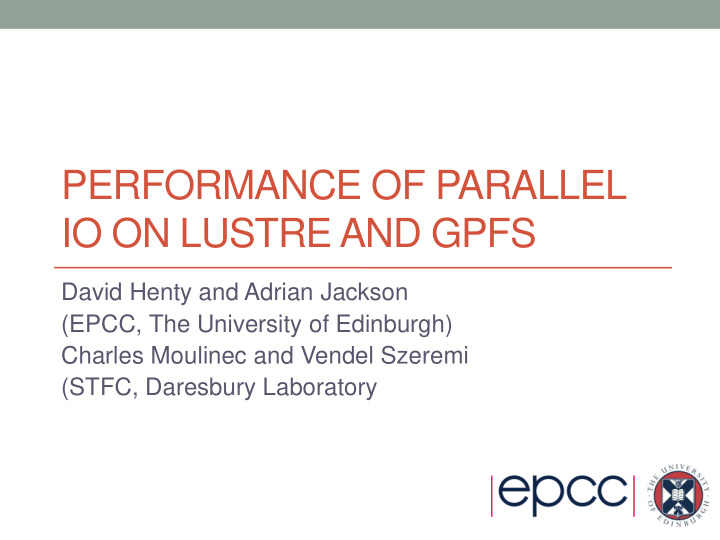



PERFORMANCE OF PARALLEL IO ON LUSTRE AND GPFS David Henty and Adrian Jackson (EPCC, The University of Edinburgh) Charles Moulinec and Vendel Szeremi (STFC, Daresbury Laboratory
Outline • Parallel IO problem • Common IO patterns • Parallel filesystems • MPI-IO Benchmark results • Filesystem tuning • MPI-IO Application results • HDF5 and NetCDF • Conclusions
Parallel IO problem 1 2 3 4 1 2 3 4 Process 2 4 8 12 16 Process 4 1 2 3 4 3 7 11 15 2 6 10 14 Process 3 1 2 3 4 1 5 9 13 Process 1
Parallel Filesystems (Figure based on Lustre diagram from Cray) OS/file-system Single logical user file automatically divides the file into stripes
Common IO patterns • Multiple files, multiple writers • each process writes its own file • numerous usability and performance issues • Single file, single writer (master IO) • high usability but poor performance • Single file, multiple writers • all processes write to a single file; poor performance • Single file, collective writers • aggregate data onto a subset of IO processes • hard to program and may require tuning • potential for scalable IO performance
Global description: MPI-IO rank 1 rank 3 4 8 12 16 (0,1) (1,1) 3 7 11 15 2 6 10 14 rank 0 rank 2 (0,0) (1,0) 1 5 9 13 1 2 3 4 5 6 7 8 9 10 11 12 13 14 15 16 global file rank 1 filetype rank 1 view of file 3 4 7 8
Collective IO • Enables numerous optimisations in principle • requires global description and participation of all processes • does this help in practice? Combine ranks 0 and 1 for single Combine ranks 2 and 3 for single contiguous read/write to file contiguous read/write to file
Cellular Automaton Model • Fortran coarray library for 3D cellular automata microstructure simulation , Anton Shterenlikht, proceedings of 7 th International Conference on PGAS Programming Models, 3-4 October 2013, Edinburgh, UK.
Benchmark • Distributed regular 3D dataset across 3D process grid • local data has halos of depth 1; set up for weak scaling • implemented in Fortran and MPI-IO ! Define datatype describing global location of local data call MPI_Type_create_subarray (ndim, arraygsize, arraysubsize, arraystart, MPI_ORDER_FORTRAN, MPI_DOUBLE_PRECISION, filetype , ierr) ! Define datatype describing where local data sits in local array call MPI_Type_create_subarray (ndim, arraysize, arraysubsize, arraystart, MPI_ORDER_FORTRAN, MPI_DOUBLE_PRECISION, mpi_subarray , ierr) ! After opening file fh , define what portions of file this process owns call MPI_File_set_view ( fh , disp, MPI_DOUBLE_PRECISION, filetype , 'native', MPI_INFO_NULL, ierr) ! Write data collectively call MPI_File_write_all ( fh , iodata, 1 , mpi_subarray , status, ierr)
ARCHER XC30
Single file, multiple writers • Serial bandwidth on ARCHER around 400 to 500 MiB/s • Use MPI_File_write not MPI_File_write_all • identical functionality • different performance Processes Bandwidth 1 49.5 MiB/s 8 5.9 MiB/s 64 2.4 MiB/s
Single file, collective writers
Lustre striping • We’ve done a lot of work to enable (many) collective writers • learned MPI-IO and described data layout to MPI • enabled collective IO • MPI dynamically decided on number of writers • collected data and aggregates before writing • ... for almost no benefit! • Need many physical disks as well as many IO streams • in Lustre, controlled by the number of stripes • default number of stripes is 4; ARCHER has around 50 IO servers • User needs to set striping count on a per-file/directory basis • lfs setstripe – c -1 <directory> # use maximal striping
Cray XC30 with Lustre: 128 3 per proc
Cray XC30 with Lustre: 256 3 per proc
BG/Q: #IO servers scales with CPUs
Code_Saturne http://code-saturne.org • CFD code developed by EDF (France) • Co-located finite volume, arbitrary unstructured meshes, predictor-corrector • 350 000 lines of code • 50% C • 37% Fortran • 13% Python • MPI for distributed-memory (some OpenMP for shared- memory) including MPI-IO • Laminar and turbulent flows: k-eps, k-omega, SST, v2f, RSM, LES models, ...
Code_SATURNE: default settings • Consistent with benchmark results • default striping Lustre similar to GPFS
Code_Saturne: Lustre striping MPI-IO - 7.2 B Tetra Mesh 1200 • Consistent with 1000 benchmark results • order of magnitude 800 improvement from Time (s) striping No Stripping Read Input 814MB 600 No Stripping Write Mesh_Output 742GB Full Stripping Read Input 814MB Full Stripping Write Mesh_Output 742GB 400 200 0 30000 40000 Number of Cores
Simple HDF5 benchmark: Lustre
TPLS code • Two-Phase Level Set: CFD code • simulates the interface between two fluid phases. • High resolution direct numerical simulation • Applications • Evaporative cooling • Oil and gas hydrate transport • Cleaning processes • Distillation/absorption • Fortran90 + MPI • IO improved by orders of magnitude • ASCII master IO -> binary NetCF • does striping help?
TPLS results
Further Work • Non-blocking parallel IO could hide much of writing time • or use more restricted split-collective functions • extend benchmark to overlap comms with calculation • I don’t believe it is implemented in current MPI -IO libraries • blocking MPI collectives are used internally • A subset of user MPI processes will be used by MPI-IO • would be nice to exclude them from calculation • extend MPI_Comm_split_type() to include something like MPI_COMM_TYPE_IONODE as well as MPI_COMM_TYPE_SHARED ?
Conclusions • Efficient parallel IO requires all of the following • a global approach • coordination of multiple IO streams to the same file • collective writers • filesystem tuning • MPI-IO Benchmark useful to inform real applications • NetCDF and HDF5 layered on top of MPI-IO • although real application IO behaviour is complicated • Try a library before implementing bespoke solutions! • higher level view pays dividends
Recommend
More recommend